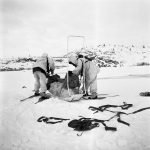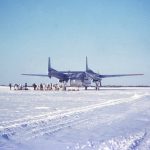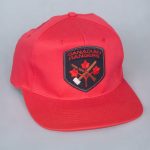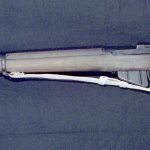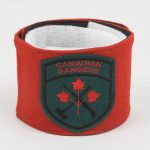1947
The Canadian Rangers
During the Cold War (1947-1991), the Canadian North took on strategic importance as North America’s first line of defence from Russian attacks. The Canadian Rangers played a significant role in Canada’s defence plan in the north. As part-time Canadian reservist militia, Rangers’ responsibilities included protecting Canada’s sovereignty by “reporting unusual activities or sightings, collecting local data of significance to the Canadian Forces, and conducting surveillance or sovereignty patrols as required.” In 1947 the Canadian Rangers became the Northern arm of the Canadian Armed Forces. The mandate of the Rangers was to “provide a military presence in those sparsely settled northern, coastal and isolated areas of Canada that cannot conveniently or economically be provided for by other components of the Canadian Forces.”
In the Northwest Territories, No. 7 Company Canadian Rangers formed in 1949 with their headquarters in Yellowknife and platoons in Fort Smith, Hay River, Coppermine (now Kugluktuk, NU), and Port Radium on Great Bear Lake.
In 1951 the military-appointed John Anderson-Thomson as the Commanding Officer of No. 7 Company Canadian Rangers. Anderson-Thomson had served in both the First and Second World Wars as a commissioned officer. Later he became a surveyor and geologist in Yellowknife and was very familiar with the North and what it would take to defend it. Anderson-Thomson’s job was to ensure that his ranks were filled with men with fighting experience and knowledge of the North.
The Defence Department was concerned about the situation in the North and came up with a plan to test northern defences in a series of military operations they called ‘Bulldog.’ In the fall of 1954, Anderson-Thomson was ordered to prepare his Rangers for ‘Operation Bulldog III,’ a mock invasion of Yellowknife by the ‘enemy,’ the 1st Battalion Royal 22nd Regiment, the famous ‘Van Doos.’
Anderson-Thomson was to coordinate his Rangers, the 24th Field Squadron of the Royal Canadian Engineers and a Company of Army Cadets – a total of 65 men armed with old British 303 Lee Enfield rifles and a dozen light machine guns – to ‘fight a delaying action’ in defence of Yellowknife. These delaying tactics allowed a unit of Princess Patricia’s Canadian Light Infantry to fly in from the south and save Yellowknife.
Anderson-Thomson was only told of the approximate date of the invasion. When it came, at precisely 15:30 on Friday, February 25th, 1955, the -40ºC weather was perfect for an arctic military exercise. The commander of the Van Doos had been ordered to secure the airport and capture stocks of aviation fuel on Jolliffe Island. Mock battles were fought with the Rangers, but the Van Doos failed to break out of the cleverly planned defensive perimeter surrounding the airport. Anderson-Thomson had also organized air cover, which started immediately ‘bombing’ the arriving Van Doos. When the Princess Pats arrived the next day, they parachuted onto Yellowknife Bay ‘without interference by the enemy,’ an enemy that a ragtag company of bush-wise Northerners had soundly defeated. The Canadian Armed Forces acknowledged that local knowledge was necessary for survival on the land and people moving in the region if any military presence in the North was to be effective.
Today there are 4,000 Canadian Rangers in 165 communities across Canada, easily recognizable in their red sweatshirts and ball caps.

